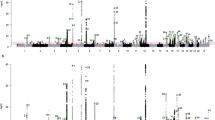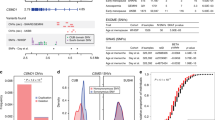Abstract
The identification of genes that control susceptibility to testicular germ-cell tumours (TGCTs), the most common cancer affecting young men1, has been difficult. In laboratory mice, TGCTs arise from primordial germ cells2,3 in only the 129 inbred strains4, and susceptibility is under multigenic control. The spontaneously arising mutation Ter (ref. 5) on mouse chromosome 18 (Refs 6,7) increases TGCT frequency5,8 on a 129/Sv background. We originally used Ter in genetic crosses to identify loci that control tumorigenesis. A genome scan of tumour-bearing progeny from backcrosses between the 129/Sv-Ter/+ and MOLF/Ei strains provided modest evidence that MOLF-derived alleles on chromosome 19 enhance development of bilateral TGCTs (ref. 9). To obtain independent evidence for linkage to the MOLF chromosome, we made an autosomal chromosome substitution strain (CSS; or 'consomic strain') in which chromosome 19 of 129/Sv+/+ was replaced by its MOLF-derived homologue. The unusually high frequency of TGCTs in this CSS (even in the absence of the Ter mutation) provides evidence confirming the genome survey results, identifies linkage for a naturally occurring strain variant allele that confers susceptibility to TGCTs and illustrates the power of CSSs in complex trait analysis.
This is a preview of subscription content, access via your institution
Access options
Subscribe to this journal
Receive 12 print issues and online access
$209.00 per year
only $17.42 per issue
Buy this article
- Purchase on Springer Link
- Instant access to full article PDF
Prices may be subject to local taxes which are calculated during checkout



Similar content being viewed by others
References
Bosl, G.J. & Motzer, R.J. Testicular germ-cell cancer. N. Engl. J. Med. 337, 242–253 (1997).
Stevens, L.C. Testicular teratomas in fetal mice. J. Natl Cancer Inst. 28, 247–267 (1962).
Stevens, L.C. The origin and development of testicular, ovarian and embryo-derived teratomas. Cold Spring Harb. Conferences Cell Prolif. Teratocarcinoma Stem Cells 10, 23–36 (1983).
Stevens, L.C. & Hummel, K.P. A description of spontaneous congenital testicular teratomas in strain 129 mice. J. Natl Cancer Inst. 18, 719–747 (1957).
Stevens, L.C. A new inbred subline of mice (129/terSv) with a high incidence of spontaneous congenital testicular teratomas. J. Natl Cancer Inst. 50, 235–242 (1973).
Asada, Y., Varnum, D.S., Frankel, W.N. & Nadeau, J.H. A mutation in the Ter gene causing increased susceptibility to testicular teratomas maps to mouse chromosome 18. Nature Genet. 6, 363–368 (1994).
Sakurai, T., Katoh, H., Moriwaki, K., Noguchi, T. & Noguchi, M. The ter primordial germ cell deficiency mutation maps near Grl-1 on mouse chromosome 18. Mamm. Genome 5, 333–336 (1994).
Noguchi, T. & Noguchi, M. A recessive mutation (ter) causing germ cell deficiency and a high incidence of congenital testicular teratomas in 129/Sv-ter mice. J. Natl Cancer Inst. 75, 385–392 (1985).
Collin, G.B., Asada, Y., Varnum, D.S. & Nadeau, J.H. DNA pooling as a quick method for finding candidate linkages in multigenic trait analysis: an example involving susceptibility to germ cell tumors. Mamm. Genome 7, 68–70 (1996).
Lander, E. & Kruglyak, L. Genetic dissection of complex traits: guidelines for interpreting and reporting linkage. Nature Genet. 11, 241–247 (1995).
Darvasi, A. Experimental strategies for the genetic dissection of complex traits in animal models. Nature Genet. 18, 19–24 (1998).
Moriwaki, K. Wild mice from the geneticist's viewpoint. in Genetics in Wild Mice: Its Application to Biomedical Research (eds Moriwaki, K., Shiroishi, T. & Yonekawa, H.) xiii–xxiv (Japan Scientific Press and Karger, Tokyo, 1994).
Silver, L.M. Mouse Genetics: Concepts and Applications 15–34 (Oxford University Press, New York, 1995).
Bonhomme, F. & Guenet, J.-L. The laboratory mouse and its wild relatives. in Genetic Variants and Strains of the Laboratory Mouse (eds Lyon, M.F., Rastan, S. & Brown, S.D.M.) 1577–1596 (Oxford University Press, Oxford, 1996).
Stevens, L.C. Origin of testicular teratomas from primordial germ cells in mice. J. Natl Cancer Inst. 38, 549–552 (1967).
Stevens, L.C. & Mackensen, J.A. Genetic and environmental influences on teratocarcinogenesis in mice. J. Natl Cancer Inst. 27, 443–453 (1961).
Poirier, C. & Guenet, J.-L. Mouse chromosome 19. Mamm. Genome 8, S353–S360 (1998).
Sokal, R.R. & Rohlf, F.J. Biometry: The Principles and Practice of Statistics in Biological Research (W.H. Freeman, San Francisco, 1969).
Sarvella, P.A. & Russell, L.B. Steel, a new dominant gene in the house mouse. J. Hered. 47, 123–128 (1956).
Simpson, E.M. et al. Genetic variation among 129 substrains and its importance for targeted mutagenesis in mice. Nature Genet. 16, 19–27 (1997).
Threadgill, D.W. et al. SSLPs to map genetic differences between the 129 inbred strains and closed-colony random-bred CD-1 mice. Mamm. Genome 8, 441–442 (1997).
Manly, K.F. A Macintosh program for storage and analysis of experimental genetic mapping data. Mamm. Genome 4, 303–313 (1993).
Dietrich, W.F. et al. A comprehensive genetic map of the mouse genome. Nature 380, 149–152 (1996).
Acknowledgements
We thank K. Youngren and T. Nelson for expert technical assistance; P. Hunt for critical reading of the manuscript; R. Redline and M.-A. Handel for assistance with histology; and X. Montagutelli for helpful suggestions regarding the genetic analysis. This work was supported by NCI grant CA75056 and by a grant from the Howard Hughes Medical Institute to Case Western Reserve University School of Medicine.
Author information
Authors and Affiliations
Corresponding author
Rights and permissions
About this article
Cite this article
Matin, A., Collin, G., Asada, Y. et al. Susceptibility to testicular germ-cell tumours in a 129.MOLF-Chr 19 chromosome substitution strain. Nat Genet 23, 237–240 (1999). https://doi.org/10.1038/13874
Received:
Accepted:
Issue Date:
DOI: https://doi.org/10.1038/13874
This article is cited by
-
Loss of Dead end1 induces testicular teratomas from primordial germ cells that failed to undergo sexual differentiation in embryonic testes
Scientific Reports (2023)
-
Testicular germ cell tumor: a comprehensive review
Cellular and Molecular Life Sciences (2019)
-
Inter-individual variation in adaptations to endurance and resistance exercise training: genetic approaches towards understanding a complex phenotype
Mammalian Genome (2018)
-
Tumor loci and their interactions on mouse chromosome 19 that contribute to testicular germ cell tumors
BMC Genetics (2014)
-
Identification of genomic locus responsible for experimentally induced testicular teratoma 1 (ett1) on mouse Chr 18
Mammalian Genome (2014)



